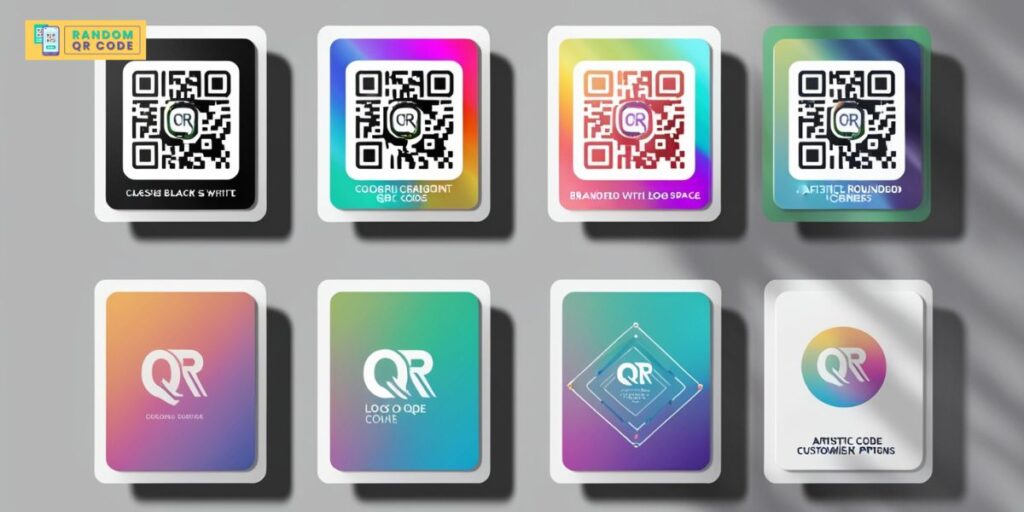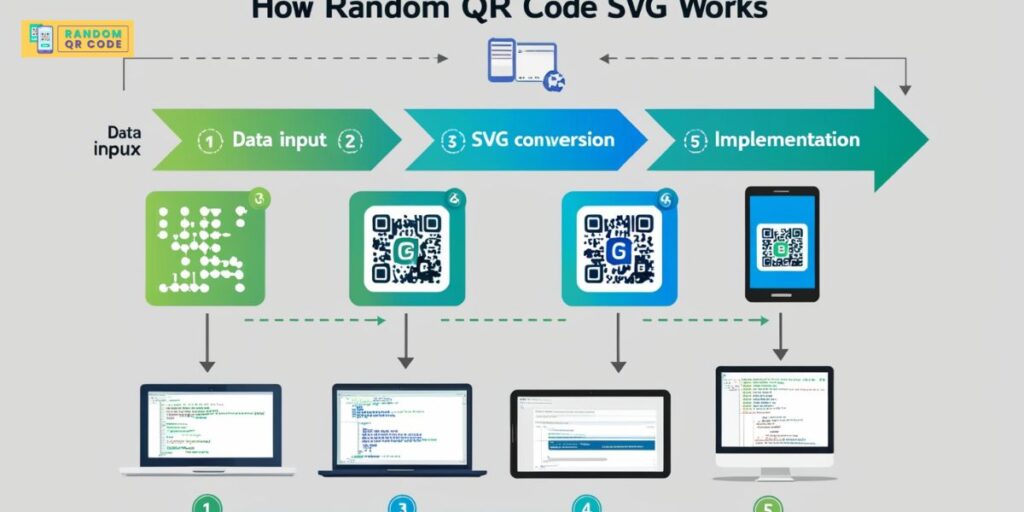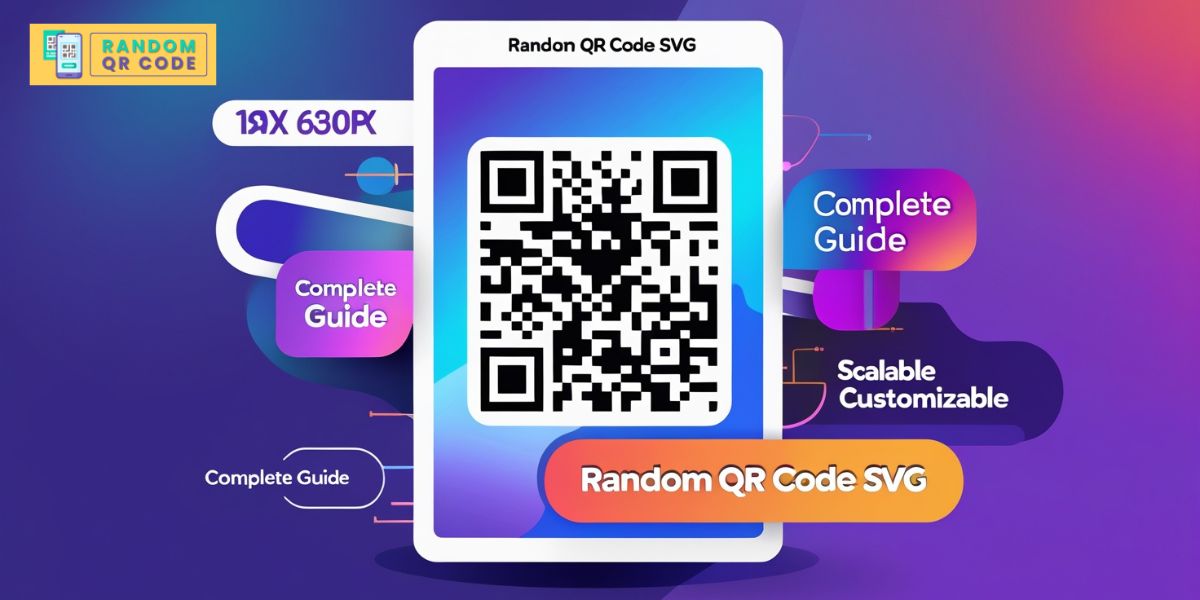Ever wondered why some QR codes look crisp and professional at any size while others appear pixelated and blurry? The secret lies in understanding random QR code SVG formats and their incredible versatility in modern digital applications.
QR codes have evolved far beyond simple black-and-white squares. Today’s businesses and developers are leveraging random QR code SVG technology to create stunning, scalable codes that maintain perfect clarity whether displayed on a business card or a billboard.
This comprehensive guide will unlock the potential of SVG-based QR codes and show you how to harness their power for your projects.
Table of Contents
What Makes Random QR Code SVG Special?
Understanding SVG Technology
Scalable Vector Graphics (SVG) represent a revolutionary approach to QR code generation. Unlike traditional raster images that lose quality when scaled, random QR code SVG files maintain perfect sharpness at any resolution. This vector-based format uses mathematical descriptions rather than pixel grids, making it ideal for responsive design and print applications.
The “random” aspect refers to the dynamic generation capabilities where each QR code can be uniquely created with variable data while maintaining the SVG format’s benefits. This combination offers unprecedented flexibility for developers and designers working with QR code implementations.
Key Advantages of SVG QR Codes
SVG QR codes offer numerous benefits over traditional formats:
• Infinite scalability without quality loss
• Smaller file sizes compared to high-resolution raster images
• Easy customization through CSS and JavaScript manipulation
• SEO-friendly with searchable text content
• Print-ready quality for professional applications
• Fast loading times on web platforms

How Random QR Code SVG Generation Works
The Technical Foundation
Random QR code SVG generation involves converting data into QR matrix patterns, then translating these patterns into vector paths. Modern algorithms can generate thousands of unique codes while maintaining consistent formatting and readability standards.
The process typically follows these stages:
- Data encoding – Converting input information into QR-compatible format
- Matrix generation – Creating the black and white pattern grid
- Vector conversion – Translating pixels into SVG path elements
- Optimization – Minimizing file size while preserving quality
- Customization – Adding colors, styles, and branding elements
Popular Generation Methods
Several approaches exist for creating random QR code SVG files:
JavaScript Libraries: Client-side generation using libraries like QRCode.js with SVG output options provides real-time creation capabilities perfect for dynamic web applications.
Server-Side APIs: Backend services generate codes on-demand, offering better security for sensitive data and consistent formatting across platforms.
Command-Line Tools: Developer-focused utilities enable batch generation and integration into build processes, ideal for automated workflows.
Customization Possibilities with SVG QR Codes
Visual Design Options
The vector nature of random QR code SVG enables extensive customization without compromising functionality. Designers can modify colors, add gradients, incorporate logos, and even create artistic interpretations while maintaining scan reliability.
Color customization goes beyond simple black-and-white schemes. Modern QR readers can interpret codes with sufficient contrast, allowing for branded color palettes that align with corporate identity guidelines.
Shape and Style Modifications
SVG format allows for creative shape modifications:
• Rounded corners for softer, more approachable designs • Custom patterns within individual modules • Artistic flourishes around code borders • Logo integration in the center quiet zone • Gradient fills for visual appeal
Brand Integration Strategies
Smart brands leverage random QR code SVG customization to maintain visual consistency across marketing materials. By incorporating brand colors, fonts, and design elements, QR codes become natural extensions of overall design systems rather than awkward additions.

Implementation Across Different Platforms
Web Applications
Modern web development embraces random QR code SVG for their responsive nature and fast loading characteristics. CSS can dynamically style these codes based on user preferences, device characteristics, or contextual requirements.
Implementation typically involves:
<svg class="qr-code" viewBox="0 0 100 100">
<!-- QR code path data -->
</svg>
The viewBox attribute ensures perfect scaling across all screen sizes while maintaining aspect ratios.
Mobile Applications
Native mobile apps benefit significantly from SVG QR codes due to varying screen densities across devices. A single random QR code SVG file renders perfectly on both standard and high-DPI displays without requiring multiple image assets.
Print Media Integration
Professional printing demands high-resolution outputs that traditional raster QR codes struggle to provide. SVG format ensures crisp reproduction at any print size, from business cards to outdoor signage.
Performance and Optimization Considerations
File Size Optimization
While SVG files are generally compact, random QR code SVG optimization techniques can further reduce sizes:
| Optimization Method | Size Reduction | Quality Impact |
|---|---|---|
| Path simplification | 15-25% | None |
| Attribute minimization | 10-15% | None |
| Precision reduction | 5-10% | Minimal |
| Compression (gzip) | 60-80% | None |
Loading Performance
SVG QR codes load faster than equivalent raster images, especially when served with proper compression. Their scalable nature eliminates the need for multiple image variants, reducing server requests and bandwidth usage.
Browser Compatibility
Modern browsers universally support SVG rendering, making random QR code SVG implementation safe for production environments. Legacy browser support can be achieved through polyfills or fallback images when necessary.
Security and Best Practices
Data Protection Strategies
When generating random QR codes containing sensitive information, several security measures should be implemented:
• Encryption of embedded data before encoding • Limited-time validity for dynamic codes • Access logging for tracking code usage • Secure transmission channels for code delivery
Quality Assurance Testing
Random QR code SVG implementations require thorough testing across various scanning devices and applications. Different QR readers may have varying tolerance levels for customization, making comprehensive testing essential.
Best practices include:
• Testing with multiple scanning apps • Verifying readability at different sizes • Checking contrast ratios for accessibility • Validating across various devices and lighting conditions
Advanced Applications and Use Cases
Dynamic Content Delivery
Smart implementations use random QR code SVG for dynamic content delivery where the same visual code can link to different destinations based on context, time, or user characteristics.
Analytics and Tracking
SVG QR codes can incorporate tracking parameters enabling detailed analytics about scanning behavior, geographic distribution, and user engagement patterns.
Integration with IoT Systems
Internet of Things applications leverage random QR code generation for device identification, configuration transfer, and secure pairing processes.
Future Trends and Innovations
Emerging Technologies
The intersection of random QR code SVG with augmented reality, blockchain verification, and artificial intelligence opens new possibilities for interactive and secure code implementations.
Design Evolution
Visual trends are pushing QR code design toward more artistic and integrated approaches, with SVG format enabling these creative explorations while maintaining functional reliability.

Tools and Resources for Implementation
Development Libraries
Several robust libraries support random QR code SVG generation:
• qrcode-generator: Lightweight JavaScript library with SVG output • node-qrcode: Node.js solution for server-side generation
• python-qrcode: Python implementation with extensive customization options • ZXing: Multi-platform library supporting various output formats
Online Generators
For non-developers, web-based tools provide easy random QR code SVG creation with user-friendly interfaces and customization options.
Professional Services
Enterprise applications often benefit from specialized QR code services offering advanced features like batch generation, API access, and detailed analytics.
Conclusion
Random QR code SVG technology represents the evolution of quick response codes into sophisticated, scalable digital tools. By leveraging vector graphics, developers and designers can create professional-quality codes that maintain perfect clarity across all applications while offering unprecedented customization possibilities.
Whether you’re building web applications, designing print materials, or developing mobile solutions, understanding and implementing SVG-based QR codes will elevate your projects’ visual quality and functional performance.
The combination of infinite scalability, small file sizes, and extensive customization options makes random QR code SVG an essential technology for modern digital communications.
Frequently Asked Questions
How to make a QR code into a SVG?
Use online converters or programming libraries that support SVG output format during QR code generation.
How do I generate a QR code to download a file?
Create a QR code containing a direct download URL link to your hosted file location.
What is the vector format for QR codes?
SVG (Scalable Vector Graphics) is the most common vector format for QR codes, offering infinite scalability.
What is a QR code that looks like a barcode?
A linear or 1D barcode format that stores data horizontally, unlike QR codes which use 2D matrix patterns.
How to make a QR code into a custom shape?
Use SVG editing tools or specialized generators that allow path modifications while maintaining scan functionality.
What is the difference between a barcode and a QR code?
Barcodes store data linearly in vertical lines, while QR codes use 2D matrix patterns for higher data capacity.
